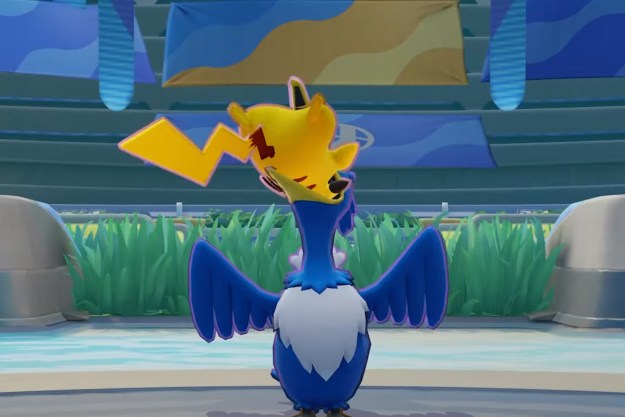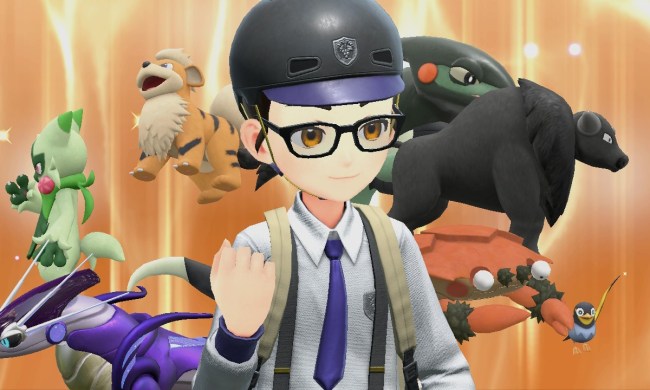
“While Pokémon Unite's core gameplay is fun, strange design choices and a convoluted microtransaction system complicates a simple MOBA.”
- Unique scoring system
- Satisfying combat
- Mostly well-balanced
- Easy to pick up and play
- Limited communication
- Oppressive microtransactions
- Frame rate and lag issues
- Lack of gameplay depth
The Pokémon games are a franchise that’s centered around journeys. Every time you crack open a case or download a new title, you know that you’re in for an adventure that will take you somewhere new in the ever-expanding world of Pikachu, Charizard, and friends. In my time as a Pokémon Trainer, I’ve traversed the land of turn-based RPGs, navigated the AR landscape, and even traveled to the depths of the roguelike realm, but I never thought I’d find myself at the base of Mt. MOBA.
Yes, Pokémon Unite is, first and foremost, a multiplayer online battle arena similar to the likes of League of Legends and Dota 2. It’s much more approachable than those famously obtuse games, though: Unite is a fun, easy-to-learn spin on the usual Pokémon formula that gives players new experiences with their favorite pocket monsters.
Pokémon Unite launched on July 21 on Nintendo Switch. It’s coming to mobile devices sometime in September, though Nintendo and developer TiMi Studio Group (a subsidiary of Tencent) have yet to announce a specific date. The game is free to start and features a variety of real-money microtransactions. Though spinoffs are nothing new to the franchise, Unite is the most recent in a long line of Pokémon mobile games that have aimed to take the franchise in new directions.
On the whole, Pokémon Unite is an approachable, if unexceptional, MOBA. The gameplay is fun and the design choices are original, but it often feels like a Pokémon-skinned MOBA rather than a true Pokémon game. Focusing on the pick-up-and-play factor means that it lacks the depth of other MOBAs and the Pokémon RPGs. The game’s mobile-centric design lends itself to a number of performance issues and suspiciously pay-to-win mechanics. Underneath all this junk, though, Unite isn’t a bad game. It just needs to shed a few layers.
A battle for the ages
Unite takes place on Aeos Island, where Professor Phorus and her assistant Erbie teach players the ropes. The island hosts Unite Battles, where Trainers gain points by having their Pokémon collect Aeos energy and scoring goals in their opponent’s goal zones. Teams of Pokémon face off against each other in 5v5 battles, with each Trainer controlling one Pokémon. The team that scores the most points before time runs out wins.
It’s a refreshingly simple experience, one that makes it so that battles never drag on for too long and losing teams always have a chance to come back. It gives players a lot of individual agency, as they don’t need your teammates’ help to defeat A.I.-controlled wild Pokémon and take their Aeos energy. Though, winning big team fights definitely requires some teammate assistance.

Despite sporting an interface that was obviously made for mobile devices, the game controls well on Switch. Basic attacks must be manually triggered and continued, leading to a fair amount of button spamming during fights. There is only a small variety of Pokémon available to play at launch, but they each have a variety of moves and passive abilities that are gained upon leveling up and evolving, which is done by defeating opponents and scoring points. You can occasionally choose between two different moves, but you only have a limited number of move slots, so it’s up to you to determine which move would be more beneficial in your particular battle.
It’s a refreshingly simple experience, one that makes it so that battles never drag on for too long and losing teams always have a chance to come back.
While I like that you can choose which move to default to in a menu outside of battle, I wish there was a way to see a short description of each move while in battle. If you don’t read up on what moves and abilities do beforehand, it can feel like you’re guessing.
Pokémon are categorized in two different ways. First and foremost, all Pokémon are either melee or ranged, which determines the average range of their basic attacks. Underneath that class, Pokémon can be attackers, defenders, speedsters, supports, or all-rounders. Of the range of Pokémon I played, each felt satisfying to play and pretty well-balanced (other than Lucario, who needs a nerf). Many Pokémon have abilities that are designed to chase down escaping enemies — few things felt more satisfying than jumping on and taking out an enemy who almost got away. Outside of combat, I wish movement was faster, particularly if you’re not playing a speedster Pokémon.
There are also a few odd omissions from the UI. For instance, there’s no way to see what the actual score of a game is. You get a few automated pings throughout the course of a match that tell you whether your team is winning or losing, but there’s no way to see the actual number. I suspect that this was to discourage people from dropping out if their team is getting stomped, but that doesn’t change the fact that there’s no way to check exactly how the match is going. I also wish that Pokémon move descriptions gave actual numbers and percentages in their descriptions rather than “does X for a short period of time,” etc.
Grinding and waiting
While in-match performance is generally good, the game’s frame rate and responsiveness take a serious hit in the game’s menus. I experienced a significant amount of menu lag when selecting a Pokémon before a match, navigating through the confusing shop interface, and obtaining the free launch week items. It feels as though the game was optimized for mobile and simply ported to the Switch. There’s no way to know what the game’s performance will be like on mobile, but Unite shouldn’t be this sluggish on a dedicated gaming console.
Mobile games are still struggling to shake the microtransaction stigma; Unite does nothing to help.
If you can make it through the lag, you can visit a variety of menus that show available Pokémon in Unite, purchasable items, and the game’s battle pass. Between ongoing events, the battle pass, and the daily gift system, there are way too many menus that all look very similar, making it easy to get lost. The cosmetic items for trainers are a fun twist, but there aren’t that many to buy as of launch, and it would be extremely difficult to obtain them without spending real-world money. The huge number of currencies doesn’t make the system any easier.

That brings us to the elephant in the room: Microtransactions. Despite the game telling you the ways that you can earn free currencies, it’s obvious that the fastest way to level up stat-boosting held items is to buy them with real money. This creates a frustratingly pay-to-win experience in that those willing and able to pay for item upgrades receive bigger bonuses in battles that can allow them to win more easily. The exorbitant upgrade prices, combined with a weekly cap on the amount of free currency that can be earned, means that those who try to grind without paying for anything will receive upgrades much more slowly than those who pay.
Mobile games are still struggling to shake the microtransaction stigma; Unite does nothing to help.
Nintendo being Nintendo
The game has a variety of Nintendo-specific issues. As with previous multiplayer Nintendo games, the communication and ping system is woefully inadequate, with only a small variety of pre-made phrases that you can use to communicate with others. Voice chat can only be used in games, not in a lobby or in the menus, and it requires a Switch-compatible headset mic.
As with previous multiplayer Nintendo games, the communication and ping system is woefully inadequate.
The friend system is annoying too, with Nintendo’s usual codes being the only way to add friends who you aren’t already Switch buddies with. I wasn’t able to test the friend lobby system, but if you have nine friends around who want to play Unite, you can create custom lobbies together.

In my play time, I also had a fairly high number of players who were AFK, both on my team and other teams. I’m not sure whether this is due to unstable user internet connections or Nintendo’s famously unstable servers, but the number seemed high enough that something needs to be done. The game does have a fair play system, where Trainers who play nice get access to additional rewards, but hopefully players who are booted because of a server error don’t lose points in this regard.
Our take
Pokémon Unite can be a lot of fun, but it’s not a must-play multiplayer experience. Pokémon and MOBA fans alike are likely to miss some of the depth of their respective titles, while the game’s supremely confusing menu system, pay-to-win microtransactions, and strange design omissions make it more difficult to recommend. There’s a good game deep in there, but it’s covered in layers of unnecessary material and bloat.
How long will it last?
Pokémon Unite is a live multiplayer game, so Nintendo and TiMi presumably have plans to support it for at least a while after launch. The game does have excellent replayability though; no two matches feel the same.
Is there an alternative?
If you’re looking for a more pure Pokémonexperience, you’re better off waiting for this winter’s Diamond and Pearl remakes or Pokémon Legends: Arceus. MOBA fans looking for a deeper game that’s still easy to play should try Heroes of the Storm.
Should you buy it?
Considering that the game is free to start, there’s no harm in downloading it and seeing if you like it. If you enjoy it, it might be worth spending a few dollars on cosmetics.



